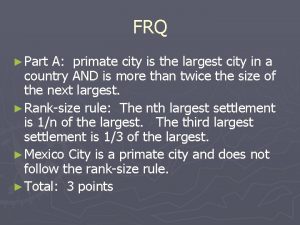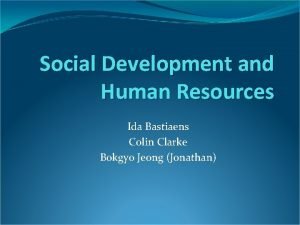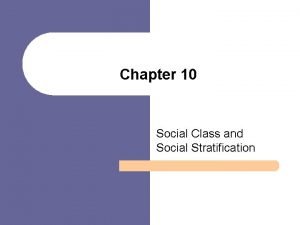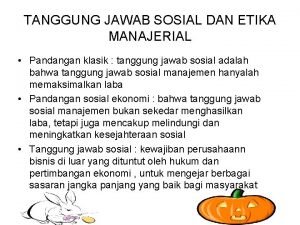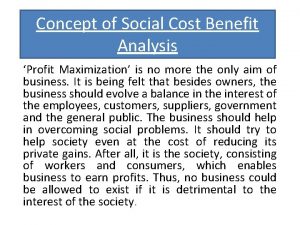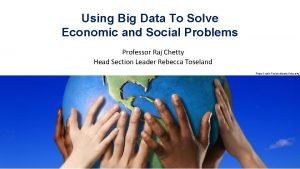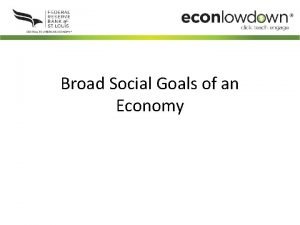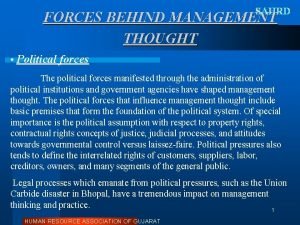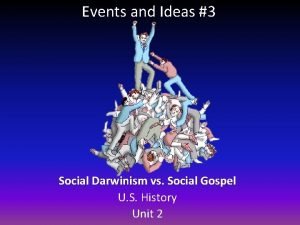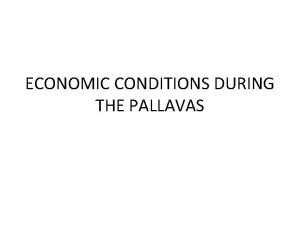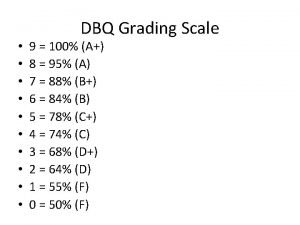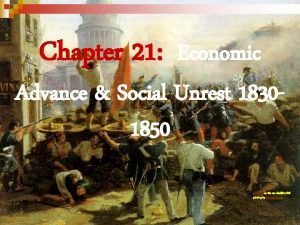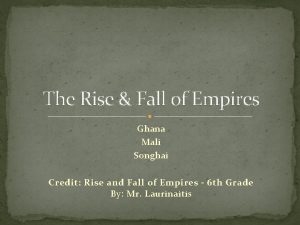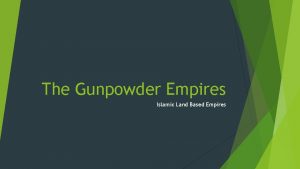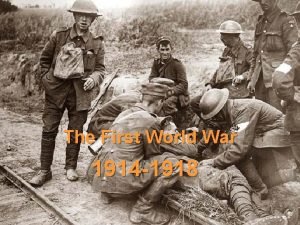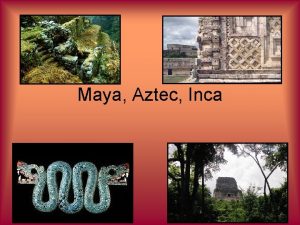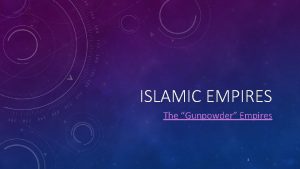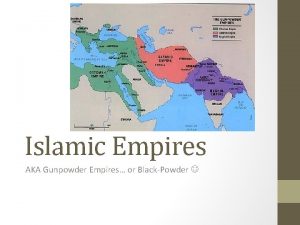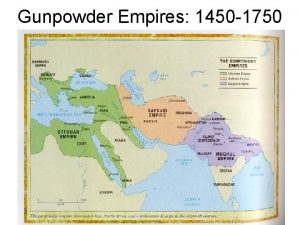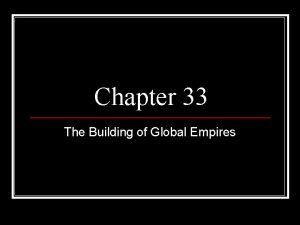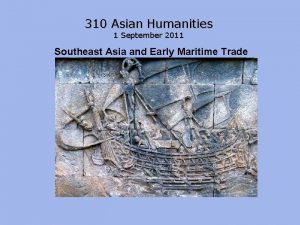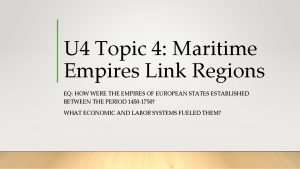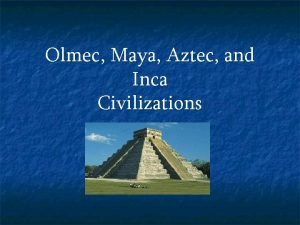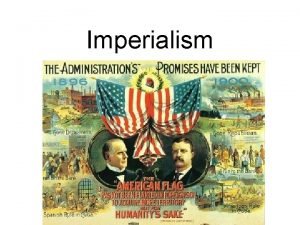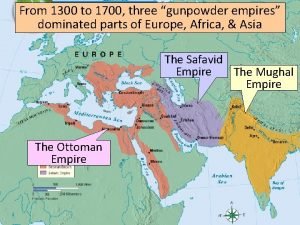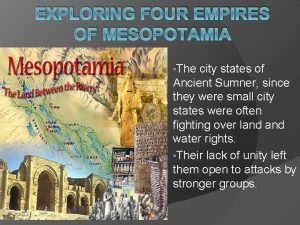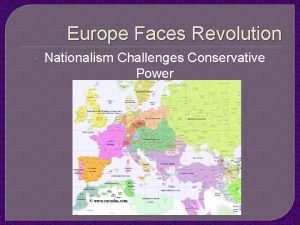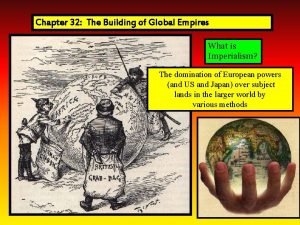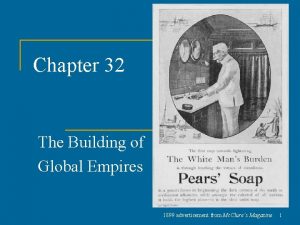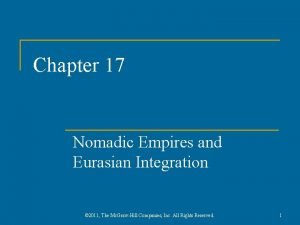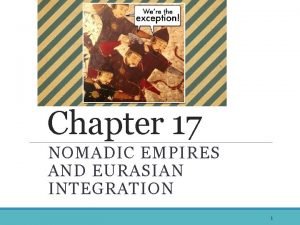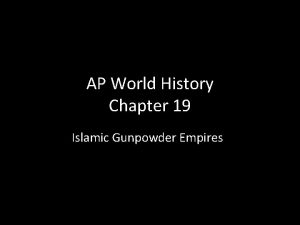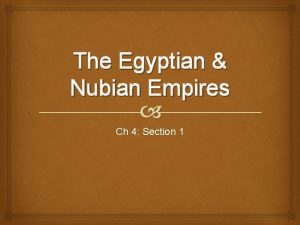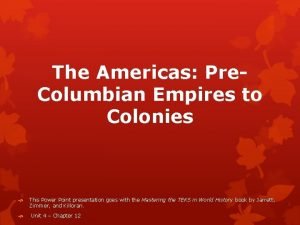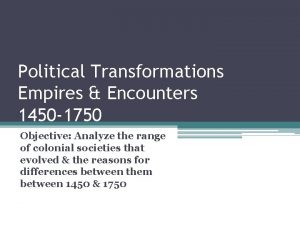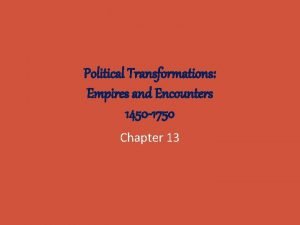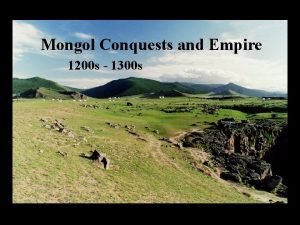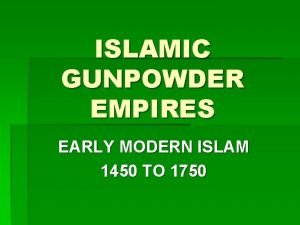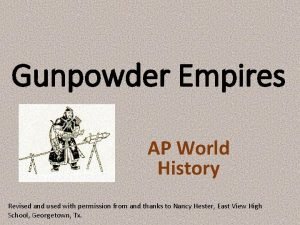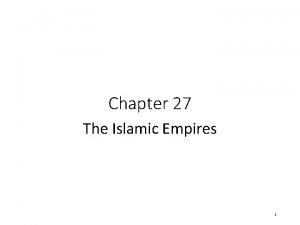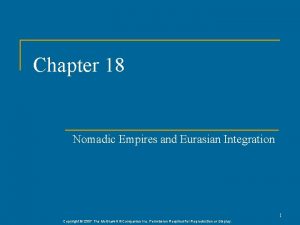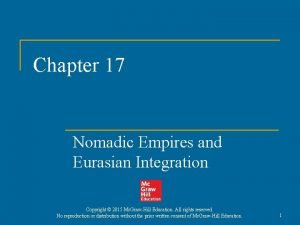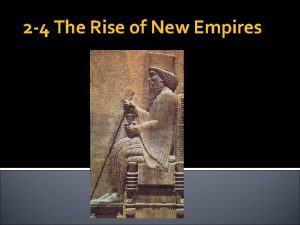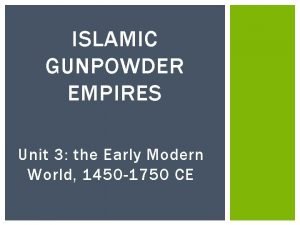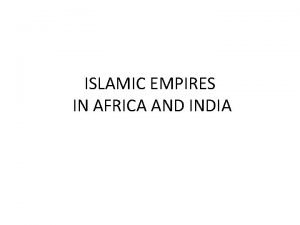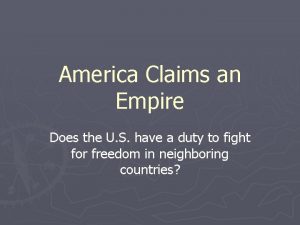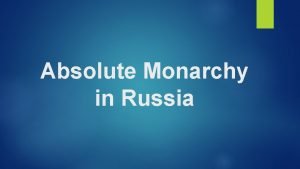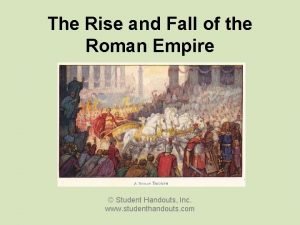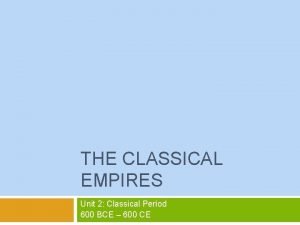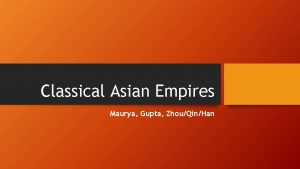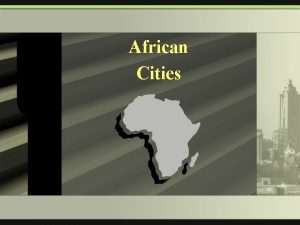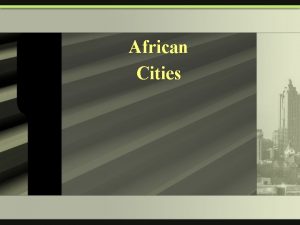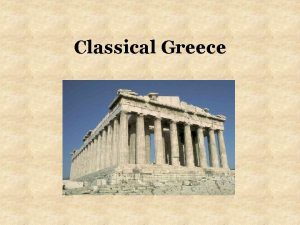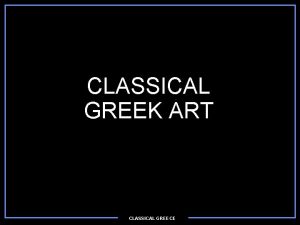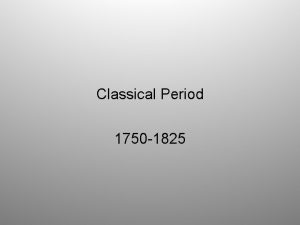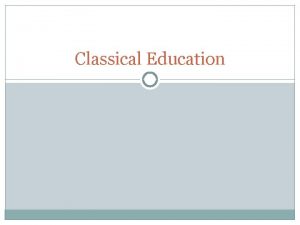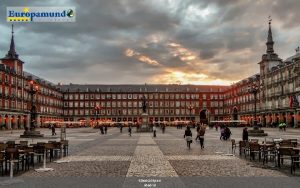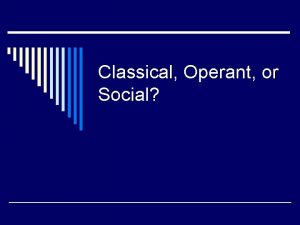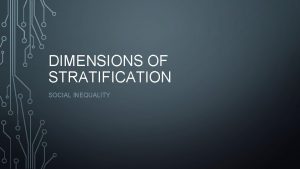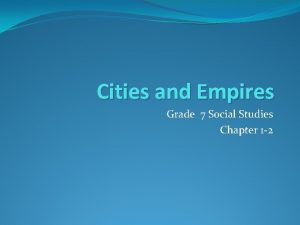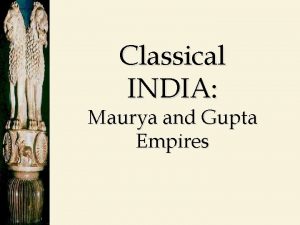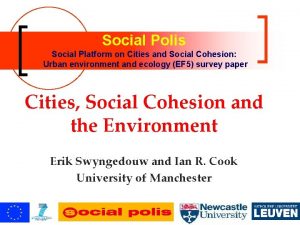Social Economic Dimensions of Empires Cities Classical empires




































































- Slides: 68

Social & Economic Dimensions of Empires -- Cities • Classical empires had a very important urban element => cities were centers of trade, public performances and rituals and political adm. § Over _______% of citizens were rural farmers/slaves; but urban focus benefitted urbanites and cities became centers of culture Public Performances & Rituals • Rome => Colisseum and various temples to a pantheon of gods (Mars, Jupiter, Apollo) became the central focus of Roman culture § “___________” became a way to control population & fame • Teotihuacan => religious shrines dominated the city; ________were performed to worship Gods (Sun, Moon) and unite people • Pataliputra => Guptas were a “theater state” & relied on ________ of Imperial court for political control (i. e. rituals, ceremonies, luxury goods) Trade • Alexandria => its location and __________helped it to serve as a waypoint between Mediterranean and Indian Ocean • Pataliputra => Mauryan and Gupta capital, located at the branching of 5 tributaries, it was a central part of the Silk Road spice trade due to its location and Mauryan roads (trade taxed & had to pass through)

Social & Economic Dimensions of Empires -- Cities Political Administration • Chang’an => Han capital contained the Forbidden city and imperial palaces which housed the _____________and emperor -- City divided into districts for control and powerful landed aristocrats were forced to move to city for control

Roman Colisseum Completed in 80 CE by Vespasian, it was inaugurated with 80 straight days of games. The capacity was over 50, 000 and it was sometimes flooded to be used in sea battles.

The Library of Alexandria Established by Alexander the Great, the library employed professional librarians and scribes from Greece and other cultures, it is said to have housed over 1000, 000 scrolls at its height

Teotihuacan -- Pyramid of the Sun was the Teotihuacan site for astrological rituals and human sacrifice

Social & Economic Dimensions of Empires -- Hierarchies • Classical empires also had very strictly prescribed social hierarchies between classes and castes § Hierarchies also existed between gender w/ ___________ dominating all classical empires (connection w/ agriculture) Social Hierarchies • Mauryan/Gupta India => organized via ________which assigned position based on job (very strict and no opportunity for advancement) § 1 st: Brahmins (priests); 2 nd = Kshatriyas (warriors and rulers); 3 rd = Vaisyas (traders, merchants, artisans); 4 th =Sudras (farmer, workers) § Ideals of ceremonial purity limited interactions between groups -- Gupta rulers gave extensive land grants to Brahmins (wealthy) • Roman Empire => divided into 2 large groups (____________) and merchants/artisans and slaves below § Wealthy landowners (patricians) controlled government during Republic and empire but Romans respected farmers (tax base) § Slaves = high percentage of Roman/Greek population (_____% +) -- Used on _______(commercial farms), public works, gladiators

Indian Caste System Indian Caste system provided social organization, economic justifications and political framework to India => formed a sort of identity far different from territorial sovereignty in Europe

Social & Economic Dimensions of Empires -- Hierarchies • Han China => free peasant farmers were backbone of Chinese labor § Top = Bureaucrats and rulers; 2 nd = free peasant farmers; 3 rd = artisans and merchants (little to no slavery; 1% or less of pop) Roman Latifundia – Romans engaged in commercial growing of wheat & olives

Social & Economic Dimensions of Empires – Food & loyalty • Classical empires had two important issues to deal with => producing enough food to supply the urban pops & maintaining loyalty of elites Food Supply • Roman Empire => food supply depended on two things free peasant laborers and slaves § ______were Roman ideal -- provided tax base & military service § Large landowners used slaves to farm large estates (latifundia) for commercial purposes (wheat, olives, sheep) -- Due to reliance huge fear of _________(i. e. Spartacus) • Han China => food supply depended on free peasant labor § Qin dynasty (and later at times during Han) forcibly ____________________land to peasants (peasant communities) § Silk weaving supplemented income (“Man as tiller, woman as weaver”) • Teotihuacan => developed __________(floating islands) to permit year round agriculture • Mayans => developed __________farming to improve production of cotton, maize and cacao

Teotihuacan Chinampas Teotihuacan chinampas were made of reeds and anchored to the shore => underground irrigation and resistance to frost made them productive year round

Social & Economic Dimensions of Empires – Food & loyalty Elite Loyalty • Roman Empire => offered conquered elites ______and emperors appointed elites to govt. posts & provided elaborate _____ § By 356 CE Rome had 28 libraries, eleven thermae, 2 amphitheaters, two circuses and 19 aqueducts • Mauryan/Gupta Empires => Gupta rulers gave large land grants to _______(used to secure legitimacy for Guptan kings) § Rulers like Ashoka also promoted arts and science (use of iron, herbal remedies, number zero) • Han China => Han rulers exempted officials from taxation & military service § Exams often “rigged” and______ families had distinct advantages Roman Thermae

Social & Economic Dimensions of Empires – Patriarchy • All Classical Age empires preserved the patriarchal organization of society found in earlier times due to the prevalent farming lifestyle § Societies formally restricted women’s rights and actions § Importance of the family unit was still revered in empires Patriarchy and Family • All classical empires had formals systems of patriarchy in place => limited women’s role in public sphere and right to inherit property § Qin and Han China => women were forbidden from owning property, no dowry (financial security) & divorce could result from no male heir -- Nuclear family predominated and Confucianism prescribed a tight code of _________(respect for parents and elders) -- Filial piety prescribed 5 relationships which formalized patriarchy 5 Confucian Relationships

Social & Economic Dimensions of Empires – Patriarchy § Roman Empire => “_________” exercised absolute control over extended household (arraigned marriage & protected women) -- Upper class women did have some additional freedoms => i. e. education, limited property rights § Mauryan/Gupta India => Kama Sutra gave formal direction to Indian women; under Guptas women were forbidden to_______ -- Indian laws also strictly constricted the actions of women => barred from studying texts and participating in rituals -- Guptas also encouraged ________to increase population => girls married as young as ____(ensure purity also) -- Rural women were also expected to participate in practice of ___ => women dives on husbands funeral pyre (preserves purity) -- Women could escape lifestyle via religion (Jainism or Buddhism), training in poetry, sexual pleasure, music (wealthy families)

Indian Sati The practice of Sati (“good wife”) was formalized in the Rig Veda and other Hindu texts => the practice was sometimes voluntary but often coerced by threats of communal ostracizing

The Decline and Fall of Classical Empires • By the 3 rd to 5 th centuires CE many classical empires (Persian, Roman, Han, Mayan and Gupta) experienced periods of decline and collapse § The fall of these empires had both internal and external dimensions Internal • Roman Empire => series of weak emperors in the 3 rd century (3 rd century crisises) led to a weakening of Roman power and decline § Weak bureaucratic officials were unable to stem the ______________(land) => weakened tax base & military recruitment -- Germanic mercenaries hired to defend borders (Roman commanded) § Environmental causes => _________weakened Roman intellectual capacity (aqueducts) -- Drought in N Africa led to a decline in wheat crops § ___________led to inability for military to defend frontiers and displaced Germanic tribes (Augustus warned of this in 14 CE) § __________by greedy emperors (i. e. less gold and copper %) led to inflation and lack of trade as barter economy returned

Nero and the Burning of Rome Some accounts place the blame for the Great Fire of Rome (destroyed up to 20 -25% of the city) at the hands of Nero who for insane or sane reasons (clearing room for his new building projects) set fire to the city and played his harp while it burned

Roman Emperors & Fall of Rome • In the later empire (180 CE onwards) Roman emperors were often assassinated and rarely served out their terms naturally => this led to the Praetorian guard becoming more powerful and emperors becoming more isolated

Roman Emperors Reigns

The Decline and Fall of Classical Empires • Han China => decades of weak rulers in the 1 st and 2 nd centuries CE led to a series of internal problems § __________=> imperial taxes had to be paid in coins & in times of drought peasant farmers forced to sell land -- Pop. growth also led to peasant farms reducing in size (______) § Imperial corruption => wealthy and Imperial court were ______and controlled by intrigue, eunuchs and concubines -- Widespread peasant unrest and lack of military service => resorted to recruitment of SE asian mercenaries (unreliable) -- Internal Rebellion by _____________in 150 CE § Population decline => by 150 CE Chinese population was only 20 M • Guptian India § Guptan rulers practice of giving large land grants to Brahmins ________________and led to peasant unrest and lack of revenue § Guptan empire was really a theater state => power rested on elaborate displays at capital were recruitment tool for association w/ empire (i. e. religious rituals, ceremonies, cultural performances) -- Decline in revenue led to decline in ceremonial importance

The Decline and Fall of Classical Empires • Persian Empire § ___________led to a weakening of the empire’s ability to defend itself => esp in India and vs Greek city states § Persian kings hoarded massive amounts of _______in palaces => excessive taxation weakened economy and led to unrest • Mayan Empire § _______led to soil erosion and declining crop yields of maize => intensified conflict between _____and led to decline • Moche state § _______and rain patterns caused the shifting of river beds and silting of existing irrigated fields => led to famine and decline

The Decline and Fall of Classical Empires External Factors • Han China => Chinese expansion (especially Great Wall) had led to the formation of ___________ § Constantly attacked Chinese borders (breakthrough in 2 nd century CE) and weakened Han through tribute for centuries § China devolved into anarchy and fractured states for over 400 years • Roman Empire => ________displaced Germanic tribes (_______) who invaded and overtook Rome by 5 th century § Excessive Roman taxation and prejudice led to rebellion after Rome settled them in 2 provinces and gave them autonomy § German tribes established their own kingdoms and local autonomy prevailed for centuries (“Dark Age”) § Roman Empire gradually shifted resources and power to East => _________became capital and _________founded • Gupta Empire => invasions by the ________weakened the Guptas & depleted the treasury (lack of ability to function as a theater state) => led to fall of Guptas by 550 CE (100’s of years of political division) § Mauryans fell to a similar fate => both were also weakened by social and political tensions created by the__________

Invasions into Roman Empire

Hun migrations

Q: How is the sack of Rome portrayed? How are the Visigoths pictured compared to the Romans?

Social & Political Impacts of Fall of Empires • As three major Empires in India, China and the Mediterranean fell they had different impacts on the regions culturally and politically. . . Roman Empire • Entered cultural “_____” where much of the _______(aqueducts) & knowledge (i. e. Greek philosophy and_________) was forgotten § ____________remained a powerful force though in both Eastern & Western worlds (influence of Constantine & Catholic Church) § Less focus on luxuries and entertainment => more on Christian religion (i. e. churches and religious iconography) § Move to decentralized social and political control => ________ -- Peasants became tied to land lords offered protection • Politically the Western Empire entered a time of disunity, ruled by chieftains & isolated Germanic kingdoms (sought legitimacy via religion) § _____________remained intact w/ Constantinople as Capital (same govt. ) => ruled by series of good emperors (Justinian) -- Better weathered invasions and many wealthy merchants moved to Constantinople due to its trade significance

Social & Political Impacts of Fall of Empires China • Entered a_______________, anarchy and invasion => ruled by local elites and nomadic groups • Culturally the lack of centralized authority weakened Confucian ideology and popularity of _______________increased § Sui and Tang dynasties made them state religions => incorporated into Civil Service exams § Buddhist missionaries traveled on Silk Road and expanded religion § Confucian philosophy and tradition of filial piety did remain and were revived by Song and later dynasties India • Entered a long period of disunity (500 yrs +) and local ruling clans/chieftains => ___________still provided a sense of unity and identity § Caste system and karma remained unchanged and ordered society § Disunity _________________=> Indian epics (Ramayana and Mahabharata) were written during disunity and Indian mathematicians invented concept of zero as well

Classical Era Trade • During the Classical Era the volume of long distance trade increased dramatically in the Eurasian sphere § American civilizations (i. e. Teotihuacan, Maya, Moche) traded on a more local level due to city state organization & lack of overland/sea connections Why & How? • Organization of ___________=> empires united regions § Led to need for increasing amounts of raw materials § Brought regions into closer contact => i. e. Alexander the Great and Hellenistic influence in India -- Less area to traverse to trade • _______and Prosperity => empire formation led to building of roads, aqueducts, canals which facilitated easier interaction § Also led to accumulation of wealth by elites & desire for luxury items • Nomadic and _________=> groups like the Scythians and Xiongnu provided protection to traders and navigated safer land routes § Benefitted from trade due to metal goods and crops § Emergence of Kushan kingdom & Parthian empire also filled in gaps between larger empires (led to safer travel)

Major States and Empires in 100 CE By 100 CE Eurasia is linked by major states and empires whereas the Americas are basically organized into small city states

Classical Era Trade Routes • 4 Major trade networks existed => each different from others. . . #1: Eurasian ___________=> overland routes that linked Han China and Roman Empire (far ends of Eurasia) § Main item traded = high quality ________ -- Romans imported ivory, indigo, silk textiles, pepper & spices -- Han China imported silver, wine, olive oil, slaves, glass § Existed for centuries but trade increased in 1 st century CE => due to___________, rise of elites and emergence of linking empires § Trade conducted by merchants in towns across the route and nomadic trading caravans (horses and camels) #2: _________caravan routes => pioneered by Berbers nomads these routes carried trade from West African societies to Mediterranean & ME § Main items traded => _________(Romans gave manufactured goods and crops like olives and wheat) § Most trade occurred with_________, not interior § Caravan trading in large groups of camels (some times 5000 + camels w/ 1000’s of traders; travel at night) § Larger trading centers like Gao & Saleh established

Silk Road (ca 100 CE) • Silk Road goes through much challenging terrain => Gobi & Arabian deserts, Himalayian Mts => 4 months to travel by caravan from Chang’an to Samarkand

Trans Saharan Trade routes • Trans-Saharan routes originated among Berber traders prior to drying of Sahara => mostly done in large caravans of camels

Classical Era Trade Routes #3: _______Network => pioneered by Phoenicians, Greeks and Selucids who discovered _______patterns (India to ME & E Africa) § Main trading items => Ivory, incenses, _____were traded by Indians for slaves, gold, woods and animals (elephants) from Africa -- Spices important for medicinal, flavoring, perfumes (lack of baths), mystical potions § Dominated by Indian ______=> used triangular _____ -- Sailed on Monsoon winds across open stretches of water #4: _________Networks => pioneered by Phoenicians and Greeks (established commercial colonies), perfected by Romans § Main trading items => glassware, olives, wheat, slaves, gold & silver -- Lanes carried trade from other networks around_______ § Ships were mainly large _________=> oared by slaves -- Tight harbors and small spaces to manuever

Indian Ocean Trading Network Phoenician and Greek explorers discovered monsoon wind patterns in Indian Ocean => led to easier long distance voyages

Indian Ocean Dhow ships were likely invented by the Chinese and used lateen sails (1 -2 masts) to effectively sail with and against monsoon winds

Roman Galleon Roman galleons were based on Greek and Phoenician ships and used sails as well as oars to travel

Roman Trade Network

Impact of Climate and Technology on Classical Trade • During the Classical Era, climate had significant impacts on trade routes => Climate/geography created barriers to trade in all regions § Indian Ocean => Greeks, Romans & Indian mapped monsoon wind patterns to sail ships across Indian Ocean (time sensitive) § Silk Road => deserts (Gobi), mountains (Himalayas) needed to be traversed (utilized oases and mountain passes) § Trans-Saharan => Berber traders mapped out oases paths and wind patterns to provide safe travel § Mediterranean => lack of reliable wind patterns led to rowed ships • Different technological improvements made the overcoming of climate and geography possible on a large scale Land based technologies • __________=> led to the use of domesticated animals (i. e. horses, oxen, llamas and camels) to be used effectively in trade § North Arabian _________=> used for trade and defense (more stable and allowed riders to use bows and weapons) -- Helped caravans defend themselves -- Better for longer distance travel (rider doesn’t kneel)

North Arabian camel saddles North Arabian saddles were a large improvement due to the seating arrangement (not kneeling) and higher placement on top of camel’s hump => allowed a stable base to use

Early Kushan stirrups The Kushan kingdom (and likely Scythian nomads) invented the stirrup in the 1 st century CE => started as a loop for big toe and evolved from there to support the entire foot § Gave riders ability to fire bows or use lances to strike from horses

Impact of Climate and Technology on Classical Trade § __________=> allowed riders to use bows and spears while riding horses (protect large caravans during travel) Maritime Technologies • ________and ________ § Lateen sails are triangular sails used by dhow ships (Indian Ocean) => can sail with or against wind (more effective use of wind) -- Aided traders to sail in larger areas of open water and quickly manuever with monsoon winds Indian Dhow ship

Nomadic Groups & Cross-Cultural Exchange ** Go over Stearns Essay on Nomads ** => What role did nomadic groups play in trade & cross-cultural exchange? Why are they well suited to do so? • Many different groups of ______played key roles in different trade routes => Q: What type of trade routes were nomads involved in? § _________in the Sahara founded trade as they traveled through the desert => knew routes and showed to others § Scythian and Xiongnu peoples were essential in linking Silk Road network and providing protection to travelers -- Also invented stirrups to make horses more useful in trade -- Participated in network to obtain ________and other luxury goods

Camel Caravan in Sahara desert

Impact of Trade on Civilizations • Alongside economic trade (i. e. goods) many other items were transmitted through trade networks. . . #1: Religion => Christianity, Buddhism and Hinduism were all spread • Christianity was spread from the Middle East to _______(Ethiopia) &_____________ • Buddhism was spread around India and then to___________ • Hinduism was spread from Indus Valley to India ** Spread was carried by a mixture of missionaries and merchants **

Spread of Classical Era Religions (300 BCE to 400 CE)

Religious Spread and Evolution • The three major religions of the Classical Age spread and evolved significantly during the time period § The universality of religions encouraged spread to acquire converts § As the religions spread they went through a variety of processes that resulted in change -- Adapting to different regional practices and desires -- Fitting into political structures and hierarchies § Spread typically involved trade routes and the activities of missionaries and merchants -- i. e. Paul => traveled Mediterranean spreading Christianity

Spread and Evolution of Hinduism • Due to the challenges of Buddhism and Jainism, Hinduism was modified by the Brahmins (kept high status) to appeal to the masses § Rituals were de-emphasized and a ____________was created to appeal to different peoples (___________) -- All gods though are manifestations of ________(Brahman) -- Most important are: o ______ (protector) => appears on earth in dire times in various forms (Rama, Buddha. . . Attempt to co-opt Buddhists) o ____ (creation and destruction) o _______(fertility goddess) => both Shiva and Devi are co-opted gods from the Dravidian tradition in S. India § Hinduism offered many ways to achieve favor => ______to deity, discipline (mental or physical =>_______) or ______on truth -- Shrines w/ statues of deities are places where followers gather => pilgrimages to shrines & Ganges to glimpse gods => provides Indian unity § Through changes that appealed to Dravidian S. Indians & absorption of Buddhist ideas, Hinduism spread throughout the Indian subcontinent

Buddhism and Hinduism in South, SE and East Asia

Devi Shrine Hindus believe that gods take up temporary residence in beautiful statues => offer clothing, food, etc… to statue in hope to glimpse God form (special blessing)

Spread and Evolution of Buddhism • Buddhism was originally born in N. India but was spread throughout India by Mauryan Emperor _____=> pillar & rock edicts along roads § Ashoka also sent out missionaries and founded many monasteries => trained people in 8 Fold Path and 4 Noble Truths § Buddhism spread to other nations primarily through the Silk Road oasis towns (Bactria region) and merchant traders in Indian Ocean -- Very popular in _______________(also China) -- Chinese tried to co-opt Siddhartha Gautama => claimed he was Chinese or disciple of Lao Tzu (Daoism) to encourage conversion • As Buddhism traveled and time wore on, Buddhism split into two sects: § _____ (Teachings of Elders) => orthodox Buddhism that denied divinity of Siddhartha & kept focus on individual path to nirvana § ________ (Great Vehicle) => attempted to appeal to desire for gods mysticism and saints by modifying beliefs -- Siddhartha was divine (Buddha image) -- ________put off enlightenment and were reborn to guide others to nirvana (i. e. Dhali Lama) => established monasteries -- ______were built to celebrate Buddha’s life and house relics

Spread of Buddhism & Hinduism

Buddhism in China After the Fall of the Han Dynasty, Buddhism became very popular (along with Daoism) in the fractured states that survived. This is an account of the origins of Buddhism by a Chinese historian. . . “What is recorded in the Buddhist scriptures is analogous to the teachings contained in the scripture of Lao Tzu (the founder of Daoism) in China. It is actually believed that Lao Tzu, after having gone to India, instructed the barbarians and became the Buddha. ” -- Yu Huan, Chinese historian ca 250 CE Q: What is Yu Huan’s purpose? Is this story true?

Spread and Evolution of Christianity • When Christianity was 1 st established Christians preached only to Jews => Jesus was savior promised in the Old Testament § Jews rejected the message and the practices of Christians => ____(1 st ______) started to preach to Romans and gentiles -- Paul founded ________=> appointed religious leaders (bishops) to coordinate activities and escape Roman persecution o Many believers embraced _______=> founded Christian monasteries (monks and nuns) -- Religion spread through Mediterranean, ME, Europe and Africa (Ethiopia)=> mainly along trade routes and in cities -- Religion was codified into Old and New Testaments (Bible) -- Christianity popular among Women, slaves, urban poor § After Constantine’s conversion and the_______, Christianity spread rapidly and underwent even further change

Spread of Christianity in Mediterranean and ME

Spread and Evolution of Christianity § Christian celebrations were moved to coincide with pagan festivals (winter solstice = Christmas; syncretism) § After the Fall of Roman Empire, the Bishop of Rome was redefined as the Pope (spiritual leader of church) § Church also accepted Roman and Greek influences -- ______becomes language of the Church -- Christian theologians (St Augustus) formalized Christian doctrine in a rational sense (appeal to intellectuals) -- _________were adopted => baptism, communion -- Preserved western learning in monasteries (monks copied texts)

Spread of Classical Era Religions (300 BCE to 400 CE)

Impact of Trade on Civilizations #2: Crops => crops were carried both from and to East Asia • Western crops introduced in China: pistachios, walnuts, spinach & sesame • Chinese crops introduced in Europe: cinnamon, peaches, plums, ginger • South Asian crops to ME => ________ • Led to development of cotton plantations in Egypt and rice farming in ME => led to introduction of ________in N Africa, China, India, etc. . § _______= channel dug in a hill or mountainside used to irrigate crops #3: Disease => diseases like __________________spread across trade routes with merchants and missionaries • Urban areas were hardest hit => why? ? ? § Led to decline in __________centers and a drop in trade => economies contracted and were forced into self-sufficiency § Lack of sanitation and proper control measures on water supply; lack of immunity to diseases • Ex: __________(Roman Empire, 166 -180 CE) => measles or smallpox § Killed 2000+/day in Rome at its height => many areas lost 1/3 of their populations § Decimated the Roman Army where disease originated (40%+ killed) § Led to economic contraction, death of emperor and decline in power of military => one of causes of decline and fall of Rome #4: Technology => examples already discussed such as lateen sails, saddles, stirrups, etc…

Qanat farming The dry environment of the N Africa, combined with desire to produce new South Asian crops led to the development of qanats (expensive to construct) => qanats spread from Persia to China, India, N. Africa, etc…



Islam Muhammed


The Hajj to Mecca

Muslim Prayer to Mecca

Islam adherents by country




 Maritime and land based empires
Maritime and land based empires Positive effects of primate cities
Positive effects of primate cities Ida bastiaens
Ida bastiaens Economic growth vs economic development
Economic growth vs economic development What is economic growth and development
What is economic growth and development Chapter 1 lesson 2 our economic choices worksheet answers
Chapter 1 lesson 2 our economic choices worksheet answers Social thinking social influence social relations
Social thinking social influence social relations Social thinking social influence social relations
Social thinking social influence social relations Weber on class
Weber on class Dimensions of stratification
Dimensions of stratification Tanggung jawab sosial manajer
Tanggung jawab sosial manajer Classical view of social responsibility
Classical view of social responsibility Abt model of social accounting
Abt model of social accounting Using big data to solve economic and social problems
Using big data to solve economic and social problems Economic social development
Economic social development Political economic
Political economic Economic social development
Economic social development Broad social economic goal definition
Broad social economic goal definition 3 forces behind management thought
3 forces behind management thought Compare and contrast social darwinism and social gospel
Compare and contrast social darwinism and social gospel Economy of pallavas
Economy of pallavas Social and economic inequalities are to be arranged
Social and economic inequalities are to be arranged Dbq grading scale
Dbq grading scale Economic advance and social unrest
Economic advance and social unrest Fall of songhai empire
Fall of songhai empire Gunpowder empires map
Gunpowder empires map Colonial empires 1914
Colonial empires 1914 Map maya inca aztec
Map maya inca aztec Gunpowder empires map
Gunpowder empires map How did the ottoman safavid and mughal empires arise
How did the ottoman safavid and mughal empires arise Land based empires 1450 to 1750
Land based empires 1450 to 1750 Chapter 33 the building of global empires
Chapter 33 the building of global empires Colonial empires 1914
Colonial empires 1914 Southeast asian alphabets
Southeast asian alphabets Empires
Empires Aztec olmec maya and inca empires
Aztec olmec maya and inca empires The policy of establishing colonies and building empires
The policy of establishing colonies and building empires “gunpowder empires” dominated
“gunpowder empires” dominated Empire
Empire Which aging empires suffered from nationalism
Which aging empires suffered from nationalism Early empires in the ancient near east
Early empires in the ancient near east Chapter 32: the building of global empires
Chapter 32: the building of global empires Chapter 32 the building of global empires
Chapter 32 the building of global empires Chapter 17 nomadic empires and eurasian integration
Chapter 17 nomadic empires and eurasian integration Chapter 17 nomadic empires and eurasian integration
Chapter 17 nomadic empires and eurasian integration Chapter 19 islamic gunpowder empires
Chapter 19 islamic gunpowder empires Chapter 4 section 1 the egyptian and nubian empires
Chapter 4 section 1 the egyptian and nubian empires Pre columbian empires
Pre columbian empires Political transformations empires and encounters
Political transformations empires and encounters Chapter 5 political transformations empires and encounters
Chapter 5 political transformations empires and encounters Islamic gunpowder empires webquest
Islamic gunpowder empires webquest Tamerlame
Tamerlame Gunpowder ap world history
Gunpowder ap world history Ottoman, safavid, and mughal empires venn diagram
Ottoman, safavid, and mughal empires venn diagram Chapter 27 the islamic empires
Chapter 27 the islamic empires Chapter 27 the islamic empires
Chapter 27 the islamic empires Chapter 18 nomadic empires and eurasian integration
Chapter 18 nomadic empires and eurasian integration Chapter 17 nomadic empires and eurasian integration
Chapter 17 nomadic empires and eurasian integration The rise of new empires
The rise of new empires Empires coloniaux 1740
Empires coloniaux 1740 Islamic gunpowder empires
Islamic gunpowder empires India empires
India empires Empires
Empires Empires
Empires How do empires consolidate their power
How do empires consolidate their power Was russia an absolute monarchy
Was russia an absolute monarchy Chapter 16 people and empires in the americas
Chapter 16 people and empires in the americas Empires
Empires The maurya and gupta empires
The maurya and gupta empires

